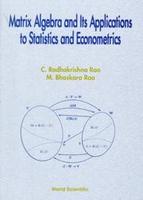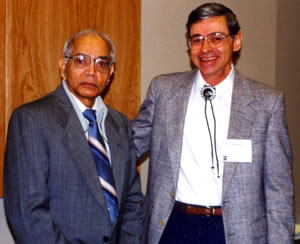Untitled Document
| |
|
Leader of statistics - Padma Vibhushan Calyampudi Radhakrishna Rao
|
|
 In 1941 a bespectacled young man came to Calcutta to secure a job. He had a first class first in M.A. mathematics from Andhra University. As he could find no place offering him research facilities, he was ready to take up any career. By chance he met a student of the Indian Statistical Institute. Curiosity made him accept an invitation to visit the institute, which he had not even heard of. What the young man saw in the three rooms of the Presidency College, to which the institute was then confined, fascinated him. In 1941 a bespectacled young man came to Calcutta to secure a job. He had a first class first in M.A. mathematics from Andhra University. As he could find no place offering him research facilities, he was ready to take up any career. By chance he met a student of the Indian Statistical Institute. Curiosity made him accept an invitation to visit the institute, which he had not even heard of. What the young man saw in the three rooms of the Presidency College, to which the institute was then confined, fascinated him.
The rattling calculating machines, the colorful charts and sheets full of data were exciting. He immediately persuaded his father to allow him to join the institute for the M.A. course in statistics. He passed the course with honours, winning a gold medal.
The young man was Calyampudi Radhakrishna Rao, who came to be a renowned statistician. He was born on September 10, 1920, at Hadagali in Karnataka. His parents named him Radhakrishna because, like Lord Krishna, he was their eighth male child. He had his schooling at several towns in Andhra Pradesh. For college education he went to Vishakapatnam. In his schools and college he won several prizes and scholarships. Although he was greatly interested in physics, his father convinced him to take up mathematics, which, he said, was in the Indian tradition.
Rao first caught the attention of the world of statistics when in 1945 he put forward the "theory of estimation". The theory enables one to find an unknown quantity for a pile of data. In due course, he developed several statistical tools. His formulae and theorems, for instant the "Cramer-Rao inequality", "the Fisher-Rao theorem" and "Rao-Blackwellisation" are now part of any standard text on statistics.
|
C. R. Rao Calyampudi Radhakrishna Rao was born to C.D. Naidu and A.Laxmikantamma on 10 September 1920 in Huvvina Hadagalli in present day Karnataka. He was the eighth in a family of 10 children. After his father’s retirement, the family settled down in Vishakapatnam in Andhra Pradesh. From his earliest years, Rao had an interest in mathematics. After completing high school he joined the Mrs. A.V.N. College at Vishakapatnam for the Intermediate course. He received his M.A. in Mathematics with first rank in 1940.
Rao decided to pursue a research career in mathematics, but was denied a scholarship on the grounds of late submission of the application. He then went to Kolkata for an interview for a job. He did not get the job, but by chance he visited the Indian Statistical Institute, and then located in a couple of rooms in the Physics Department of the Presidency College, Kolkata.
He applied for a one-year training course at the Institute and was admitted to the Training Section of the Institute from 1 January 1941.
In July 1941 he joined the M.A Statistics program of the Calcutta University. By the time he passed the M.A. exam in 1943, winning the gold medal of the University, he had already published some research papers! |
 |
In 1943 he joined ISI as a technical apprentice, doing research, teaching in the Training Section of the Institute and at Calcutta University and assisting Professor Mahalanobis in editing Sankhya the Indian Journal of Statistics.
In 1946 he was deputed to the Cambridge University on a project. While working full time on this, he also worked in the genetic laboratory of R.A. Fisher, the father of modern statistics and completed his Ph.D. under Fisher. |
The Cramer-Rao inequality eq. was discovered by Professor C.R. Rao (left). Dr. B. Roy Frieden, Professor Emeritus, Optical Sciences Center, The University of Arizona (right) |
By this time Rao had already completed some of the work which carries his name: Cramer-Rao inequality, Rao-Blackwell theorem, Rao’s score test and Rao’s orthogonal arrays. The C-R inequality states that the ability to know any measured quantity is strictly limited by the amount of Fisher information that is available. A consequence is that the Fisher information becomes the basis for deriving laws of science via EPI principle. This is not unexpected since scientific laws are intrinsically tied into measurements: the laws both theoretically define measurements and (as we found) are created in response to measurements.
Rao considers statistics to be a "very human science". What looks like a collection of numbers has indeed an immense significance in daily affairs. For example, his own technique of orthogonal (rightangular) arrays in the "design of experiments" assists industry in increasing production to the maximum. His contributions to multivariate analysis can be used in medical diagnosis, plant breeding and biometry. Biometry is the mathematical study of measurements in biology such as height, skull size, size of tail and geometry of flowers.
He returned to ISI in 1948 and in 1949 was made a Professor at the very young age of 29. He headed and developed the Research and Training Section of the ISI, and went on to become Director of the ISI. He became the associate editor of the Sankhya in 1964 and became the editor in 1972. He left ISI in 1978 and joined the University of Pittsburgh.
He has received 29 honorary doctoral degrees from universities in sixteen countries -including Australia, Brazil, Canada, Greece, Finland, India, Germany, Greece, Poland, Spain, Slovakia, and Switzerland - around the world.
Professor Rao is author of 14 books and about 350 research papers published in professional journals, and has mentored research work of about 50 students for the Ph.D. degree, most of which are employed in universities and research organizations around the world. Professor C. R. Rao served ‘Indian Statistical Institute’ (1944-1992) in different positions before retiring as its Director.
After retiring from ISI in India, Calyampudi R.Rao moved to Pennsylvania State University, and has served at several other universities of the world as a Visiting Professor.
Areas of research contributions of Professor Rao include
- Estimation Theory ,
- Inference & Linear Models,
- Multivariate Analysis,
- Combinatorial Designs,
- Biometry ,
- Mathematical Genetics,
- Generalized Inverses of Matrices, and
- Functional Equations.
Awards & Medals:
- Government of India awarded him Padma Vibhushan.
- President Bush, on June 12,2002, decorated him with ‘NationalMedal of Science’
- Wilks Medal of the American Statistical Association,
- Guy Medal in Silver of the Royal Statistical Society,
- Megnadh Saha Medalof the Indian National Science Academy,
- S. S. Bhatnagar Award
- JC Bose Gold Medal of Bose Institute, and
- Mahalanobis Centenary Gold Medal of the Indian Science Congress.
In his honor,
- Penn State University has established C. R. and Bhargavi Rao Prize in statistics,
- Osmania University has founded C.R. Rao Advanced Institute forMathematical and Computer Sciences (AIMCS).
Mr. Rao’s family:
Professor Rao was married to Smt. Bhargavi Rao on September 9, 1948 and has two children – daughter, Dr. Tejaswini Rao, and son, Veerendra Rao – and two grandchildren Amar and Rohith, all in USA.
Contact:
Name: CALYAMPUDI R. RAO
Address: 325 JOAB L. THOMAS BLDG
UNIVERSITY PARK, PA 16802
Phone: +1 814 865 3194
Title: EBERLY PROF EMERITUS
Admin_Area: SCIENCE - EBERLY COLLEGE
Department: STATISTICS
Campus: UNIVERSITY PARK
Country: India, Philippines, Trinidad & Tobago
Email : crr1@psu.edu (crr1@email.psu.edu) |
|
|
|
|